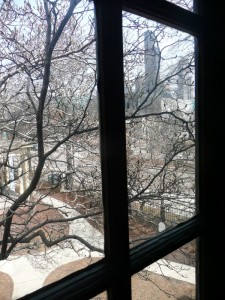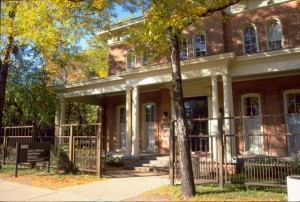If you don’t know who John and Hank Green are, well, you should. On youtube, they’re known as the Vlogbrothers (http://www.youtube.com/user/vlogbrothers) and have been making fun, interesting, silly, and profound videos since ancient times. Which, in youtube terms, is like 3 or 4 years ago. Anyway, within the last year they started a series called “Thoughts from Places”, which is exactly what it sounds like. Go somewhere, bring along a video camera, and record your impressions. To see some of them, hit the link above and search for ‘thoughts from places vlogbrothers’. I wanted to do my own version, but I’m at work and didn’t have a video camera with me, so here’s my textual attempt…
——————————————-
If you were me – and let’s both be thankful that you’re not – you would often get sick of staring at your computer screen, and your posted post-its, and your to-do lists and seek momentary mental escape. You’d turn away from that wall of stuff, of have-to’s and commitments, and rotate to your 7 o’clock (Ok, fine! More like 7:30 Let’s not quibble over the details.) and look out the window. This is what you’d see.
Right outside the window is a tree. Magnolia, I think. Or perhaps something particularly magnolia-esque. What do I know? I’m no botanist. The tree stands in the courtyard between the building where my desk is and the other building that makes up our museum, an 1856 Italianate house where we keep all the exhibits. Last year I’d see a lot of squirrels in the branches and they’d sometimes hop onto the window ledge and look into the office as if they wished they could come inside with us. Be careful what you wish for, boys. Here there be responsibilities. This year, though, has been fairly squirrel-lite. I have seen a bright red cardinal a few times. One day he spent a good five minutes tapping away at the windowpane. I’m pretty sure that’s supposed to be a bad omen.
Just past the courtyard is Halsted Street, which Google Maps tells me runs from Grace Street in Wrigleyville for 35 or so miles all the way south to Chicago Heights. On the way there, it passes 196th Street. I didn’t even know the street numbers went that high. In the museum, we have a video from the 1930’s (I think) that shows images of the entire route from south to north. Today it would all be an urban gumbo of residential, commercial, and industrial. Back then there was that, sure, but there was also rural. Like, horse-pulled plow rural. Amazing how much and how fast our cities grow.
Across Halsted from work is the gym. This is one of the “benefits” of working at a large university. The gym is right there! And it’s cheap! And they’ll take my membership fee right out of my paycheck! Pre-tax! But I think we’re in an abusive relationship. And I’m definitely the bad guy. The gym wants nothing but the best for me and usually gives me all it can. And what do I do? I ignore it, curse at it, and often tell it that I wish it didn’t exist. All it wants is love and all I offer is insult. Thirty years from now, the gym will need some serious therapy.
The gym abuts good old Interstate 90/94 which might be called “The Dan Ryan” or “The Edens”. Maybe both? Why can’t Chicago just call its freeways by their number like the rest of the free world? All I know is that that particular stretch of road is never not traffic jammed, I drive on it as little as possible, and I hate it.
But that’s why bridges were invented, because just across that horrible stretch of road rises the great city of Chicago. I use the term “great” here to indicate size, not any kind of emotional connection. Although, that may be coming. I’ve lived here for a year and a half and, I’ll confess, there was a time I was convinced I would never be a fan. But I thought that about Vermont only to wake up one morning and realize that I had fallen in love – hard – for that previously cursed place. Could the same happen here? Maybe it’s happening right now, just at geologically slow speeds. All I know is that I’ll find myself coming around the corner on one of the CTA lines and get a cityscape view I haven’t seen before, or I’ll be walking around downtown and notice some hidden and long forgotten architectural detail, or be running errands and realize what a great variety of various ethnic non-pretentious holes-in-the-wall there are, and I’ll have moments of “Ok, yeah, I get it.” Dominating the view from my office window is, of course, the Sears Tower. And yes, I know it has a different name. Tell you what; I’ll start calling it the Willis Tower just as soon as whatever the Willis Company is does something as awesome as selling khakis, lawnmowers, video games, and Craftsman tools all under one roof. At the top of the tower is the observation level which now features plexiglass pods so you can stand out away from the side of the building and look down 103 floors to the street. I think about that, and I remember being up there, looking out at three states and 10 million people and feeling very small.
Of course, just past the buildings great and small that make up the city is the lake. Lake Michigan. No, I can’t see it from my desk, but I know it’s there. I can feel it. The lake is that unbroken connection between here and there. Yeah, I know we have roads, and trains, and airplanes. But the lake, and the rivers, and the ocean… they were there before all that and they will be there after. The lake makes me feel connected to those that I am far from. Fievel may have found comfort in the pale moonlight, but I find comfort in knowing that the same water I’m next to touches, in some fashion, the waters of my loved ones.
And the window itself? The window is on the second floor of a building built in 1907 as the dining hall for a group of social reformers. They tried to make life better for those less fortunate. Today, we tell their stories and try to work within the spirit of what was started here so many years ago. The window is a reminder that the real work isn’t at my desk at all, but out there. Telling stories, creating context, fostering connections.
Making the world better.




